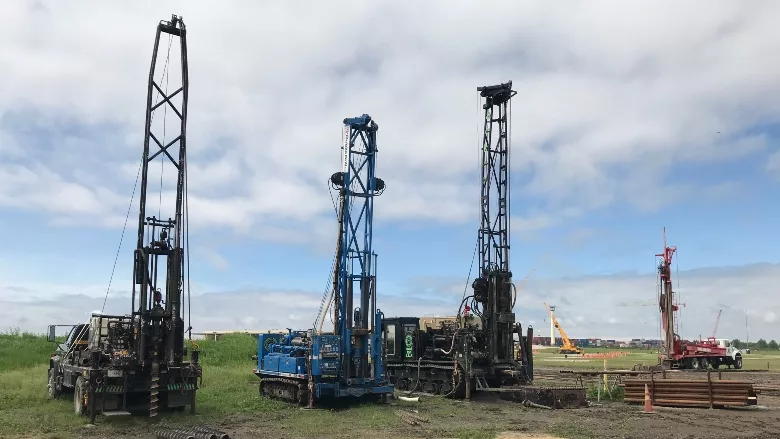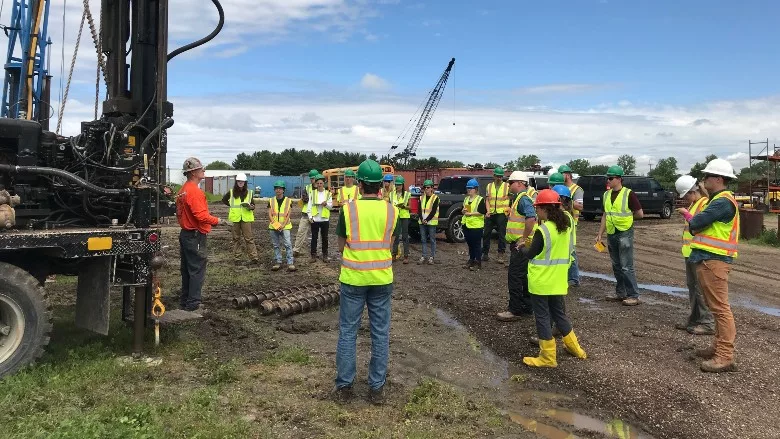Groundwater Week Special Feature
The Simple ‘5x3 Goals’ System for Drill Crew Evaluation
Mapped-Out Goals, Scheduled Check-Ins Keep Growth on Track

Drillers do not hesitate to literally go to the middle of nowhere and put a hole in the ground for the company they work for. Using the “5x3 Goals” method, supervisors can find the “why,” helping both the company and the employee grow.
Source: Brock Yordy

The equipment, of course, has its place. But success for any company comes down to the success of the people inside it.
Source: Brock Yordy

Skills training should be part of any company’s goals for an employee. What an employee creates as goals may — and probably will — differ from those set by the company.
Source: Brock Yordy
In my article, “Is it Time for Drilling to Retire the Term ‘Helper’?,” I introduced you to my simple progress-tracking method using a notecard. I call it “5x3 Goals.” Why? As a young driller, I always wanted a 5x3 mud pump on my rig. Every time I discussed the idea at a show or convention, some old driller would sarcastically shoot me down or create some unrealistic excuse as to why it wasn’t possible.
“They are not common and too expensive, kid.”
“The piping on the rig wouldn’t allow for the flow. Come on, get it together.”
However realistic, the goal drove me, if only in theory. In practice, using this method is easy. Anyone can remember five goals on each side of the notecard with three meetings: one in the first 30 days, one at 6 months and one at a year’s end. On one side of the 3-by-5-inch notecard, the employee writes five goals for the first year. On the other side, the company sets its five goals for the employee.
The employee aims to complete one goal from each list by that 30-day meeting, two more of each by 6 months, and the remaining goals by the end of the year. This gives our employees purpose while aligning the company’s expectations and goals for continued success. Let’s drill deeper into the goal creation and review process.
Creating Goals
Employees find the opportunity to create five goals — without the company’s guidance — priceless. It gives them ownership, accountability and purpose in their growth as a professional in the industry. For the company, it allows us to see the inspiration and motivations within our teams. Furthermore, it gives the company a chance to help those teammates that require inspiration and improvement before we lose them altogether.
The challenge for both employee and company involves creating quality goals achievable within a given timeline. The difficulty for the employee comes from wanting to create goals they believe the boss or company wants, versus goals they find motivating. Yes, some goals have mutual benefits for growth, like strong safety goals or maintaining licenses through continuing education credits. However, the company should establish these goals and encourage employees to focus on their development. When asked for advice on goals from my team, I suggest they think about where they want to be in the following year, professionally and personally. If one of their goals is to buy a home, that should go on the list. That is just as important as becoming a competent driller.
On the other hand, company goals for the employee should be clearly defined, achievable and created to help push the company into the following year. Here are my top five for my team; you can choose the timeline and metrics.
- Always operate safely.
- Create Job Safety Analyses (JSAS) or Standard Operating Procedures (SOPs) for all processes.
- Improve one process through technology or better practices.
- Obtain/maintain a license or professional certifications.
- Identify cost-cutting measures or efficiencies for regularly performed work.
All goals require documentation and collaboration. As an industry, we are excellent at using our hands, yet terrible at using those hands to write down important aspects of the job.
The Review Process
The process requires maintaining the meeting schedule for reviews. In construction, we can easily find ourselves focusing on the next job, the next quarter or the next component of company growth. The next thing we know, it’s December, and we have missed that critical 6-month review. Of course, all company goals are essential to success, but none are possible without people. We must maintain our review meetings to know that our most valuable component is growing and happy.
Ideally, the 3-by-5 method creates the opportunity to meet one-on-one with our people four times
- The first at the meeting to establish these 10 goals.
- The following 1 month
- Then at 6 months.
- Finally, a year-end review.
One of my favorite sayings in our industry goes, “If you do not schedule your equipment’s maintenance, it will schedule it for you.” Our team is the same. If we do not schedule and maintain that one-on-one review time, they will schedule it when they give their notice. The review process helps employers understand what happens daily in the field. It also helps them to discover what drives their employees right now, as well as their long-term goals.
I start every meeting with the same three questions to hear what they need and how I can help them get there. Each has follow-ups that add detail to the conversation.
- Do you enjoy what you do?
- Do you enjoy your role?
- Do you enjoy this industry?
- Do you feel safe?
- Do you feel safe in the field?
- Do you feel financially safe?
- What do you want to do next?
- What do you want to learn?
- Where do you want to go?
- What role do you see yourself playing in the future?
These questions help develop the future of the company. These questions give our people purpose at the company and in their future outside the company. After we cover these three questions, time to jump into the 3-by-5 goals. I let the employee choose which side we start on. Again, the process can be simple and should not be a pass-or-fail situation. (Yes, it is a failure if the employee has lost their card, but everyone should get at least one “do-over.”) Every meeting presents an opportunity to learn, improve and grow. Some sessions take longer and involve difficult conversations. In others, you can savor that moment when you see the twinkle of inspiration in their eyes.
Better Communicators
In 2023, I challenge the construction and drilling industry to become better communicators. We do a phenomenal job of celebrating wins. We also do a great job of shouting from the platform as the project starts to fail. In both situations, we are very direct, and everyone onsite knows how the case is progressing.
We are terrible when discussing performance improvement or, when it comes to operating a new, million-dollar rig, expectations for when an employee will be ready.
We are terrible when discussing performance improvement or, when it comes to operating a new, million-dollar rig, expectations for when an employee will be ready. The industry has become too ready to deploy tactics like passive-aggressive sarcasm toward poor performers or bad excuses as to why an employee can’t have more responsibility. True leaders are candid with their people because it is the only way to keep them moving forward.
We are almost a quarter of the way into the 21st century. The millennial generation did not stay in our industry. Our businesses are no longer 90% family, with honor tied to the family name. The unemployment rate is 3.7% (4th quarter 2022). New hires today can research and pursue almost any role, but fewer choose construction and fewer still pick the drilling industry. Employees we attract and retain will require purpose. They want a future with milestones. It is time for us to share knowledge by creating objectives, expectations and achievable goals for a new generation of operators, drillers and pump technicians.
Looking for a reprint of this article?
From high-res PDFs to custom plaques, order your copy today!





